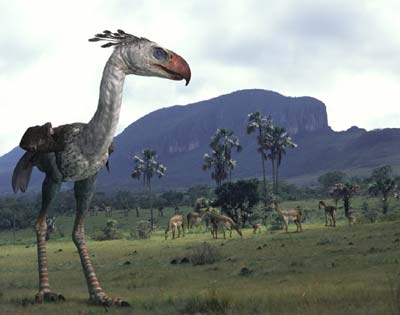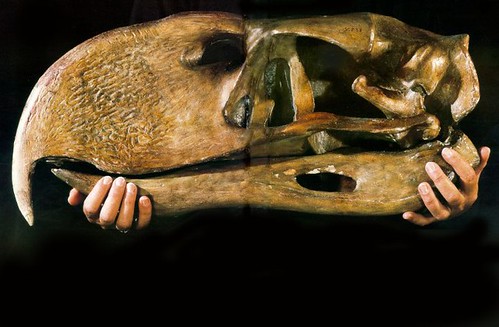University of Florida paleontologist Bruce MacFadden said his team has determined that a prehistoric 7 foot tall flightless "terror bird," Titanis walleri, arrived in North America from South America long before a land bridge connected the two continents. The bird apparently island hopped to North America on islands that make up the mountains that now form mountains on the isthmus of Panama.
"It was previously thought that Titanis immigrated to Texas across the Panamanian land bridge that formed about 3 million years ago connecting North and South America," said MacFadden, who is a curator of vertebrate paleontology at the Florida Museum of Natural History at UF. "But the rare earth element analysis of a fossil Titanis bone from Texas determines its age to be 5 million years old. This shows that the bird arrived 2 million years before the land bridge formed, probably across islands that formed what today is the Isthmus of Panama."
Titanis walleri is a member of the Phorusrhacid family and holds the record as the largest predatory bird known to have existed. It weighed approximately 330 pounds, had powerful legs and feet and a head larger than a man's. It is known in the fossil record from a single toe bone found in Texas, and in Florida from approximately 40 bone fragments from different parts of the bird's body. MacFadden's team also analyzed six specimens from the Santa Fe River in north Central Florida.
MacFadden said his team used an established geochemical technique that analyzes rare earth elements in a new application to revise the ages of terror bird fossils in Texas and Florida, the only places in North America where the species has been found. Rare earth elements are a group of naturally occurring metallic elements that share similar chemical and physical properties.
When an animal dies, its porous bones absorb groundwater as they fossilize. As local groundwater conditions change, the rare earth elements' concentrations likewise change, resulting in a unique chemical signature.
"We used rare earth elements because they're highly specific to certain time periods and different groundwater conditions," MacFadden said. "This is the first time that the uptake of rare earth elements during the early stage of fossilization has been used to determine the age of fossils in North America."
Geologists have used the technique to study igneous and metamorphic rocks, but only one other researcher, Clive Trueman from the University of Southampton in England, has used this technique to date the age of fossils.
"[Using this method] we found that the Titanis fossils were 2 million years old and not 10,000 years old as had been suggested," MacFadden said. "This also shows the last known occurrence of Titanis in the fossil record and reflects its extinction."
The study will be published 23 January in the online version of the journal, Geology, and will be featured in its February print edition.
Cited story.
.



Wow. Packing the time machine for your Pliocene Florida vacation? Be sure to bring a firearm.
Amazing article! Giant birds!
Hoooooooooooooooollllllllllllllllyyyyyyyyyyyyyyyyy crap those birds r friggen huge!!!!!!!!!!!!!!!!!!!!!!!!!!!!!
But did it taste better than CHICKEN...